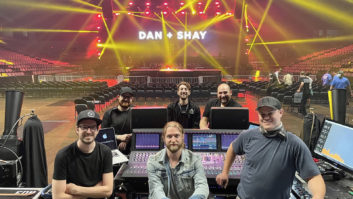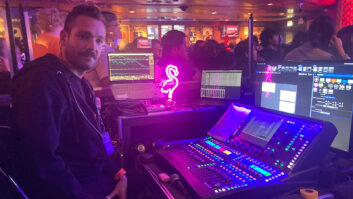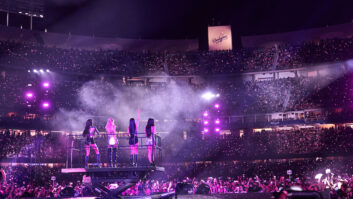
Part of a new breed of tuneful pop punksters on today’s music scene,spikey-haired, tattooed and pierced Good Charlotte manages to addressthe prime topic of the genre — alienation felt by outsiders— but with a somewhat sunny and positive approach that sends 10-to 14-year-old girls into paroxysms of hysteria. Rather than beingintense and enraged, their catalog of songs explores relationships,lifts spirits and displays empathy — this is clearly punk of a new stripe. Good Charlotte’sThe Young and the Hopeless tour has been making its way aroundthe country for a few months now, courtesy of Cleveland-based EighthDay Sound. Mix caught up with the band at Chicago’s AragonBallroom.

Good Charlotte crew chief and monitor engineer Vince Buller ridesherd over a straight-up rock ‘n’ roll rig with the versatility torapidly switch gears from a 2,000-seat theater one night to a hockeyrink with ample space for 10,000 shrieking females the next. Buller, anative of Birmingham, England, is probably best known for a 10-yearstint he pulled with the Black Crowes; more recently, he went out withBjörk and Tracy Chapman. He signed on to be ringleader for ahard-working Good Charlotte crew that includes house engineer GaryFerenchak, front-of-house tech Doug Fowler and system tech MartyTarle.
Each night, Good Charlotte’s show begins in total darkness. As thelights come up and the crowd begins to make out the silhouettes of theband as they take the stage, pandemonium ensues. “You could gooseit up for them,” Buller says of his monitor levels at thatmoment, “but there’s really little you can do to overcome thenoise of the crowd. They’re used to it by now anyway, and sort of gointo autopilot mode until the audience calms down. Once that happens,it’s clear sailing, mate.”
Just as in the house, Buller’s world onstage is based around d&bloudspeakers, amplification and processing. Presiding over a YamahaPM4000 used to orchestrate the activities of 22 inputs, he maintainsfour mixes using two wedges each across the front of the stage, a pairof sidefills flown above the fray to help reduce chances for feedback,a wedge in front of the drum riser pointing at the rear of thefrontline (appropriately dubbed the “butt mix”) and“Texas headphones” (two enclosures on each of the immediatesides of the drum kit) for the drummer.
“Once the band hits the stage, they are moving all over theplace at warp speed for the show’s full 90 minutes,” Bullerrelates. “That’s why I have full mixes everywhere. With theamount of activity going on, trying to create individual zones fordifferent players would be a useless proposition.”
Monitor world’s outboard gear is, according to Buller, simply the“regular stuff”: BSS graphics, compressors and Drawmergates. “There’s nothing high-tech,” he humbly admits.“After all, this is all about rock ‘n’ roll: getting it togetherand then making it as loud as you can get it, while still keepingthings clear and intelligible.”
In the house, the d&b P.A. comprises two-box full-rangeenclosures and subs. “We fly most of the time, but occasionally,we stack because of the widely varying venues we turn up in,” FOHtech Fowler explains. “The nice thing about this rig is that wecan basically build it however we want to.”
A three-way splitter onstage splits once for Buller’s PM4K, againfor FOH engineer Ferenchak’s Midas XL4 and a third time to accommodatea Digidesign/Focusrite control surface employed to govern events withina Pro Tools setup that is used to capture each evening’s performance.With no intended purpose at the moment outside of the purely archival,the recorded Pro Tools tracks are an amalgam of 16 channels taken fromthe snake through the Focusrite control surface and eight others takenas direct outs from the XL4.
Outside of his Pro Tools environment, Ferenchak confides that there“aren’t a lot of bells and whistles out front.” With mostof his compression done in subgroups — he basically subs all ofthe instruments and compresses them lightly on the guitars and fairlyheavily on drums and bass — he does two subgroups in mono of kickand snare, another pair of the rest of the drum kit in stereo, squashesit, cranks the outputs and then brings it up in the mix.
“After all that, it can’t help being anything but huge,”he says matter-of-factly. “The toms will kind of explode, butit’s not out of sync with the rest of what’s going on. Others who mixthis kind of stuff are more into the older front-loaded systems,because they can make them louder or at least have them be perceived aslouder. But for me, this isn’t about being loud, it’s about balance andclarity.”

Portraits of the band and crew, by Mix photographer SteveJennings
Rocking out onstage:





Pictured from left: FOH engineer Gary Ferenchak, monitor engineerVince Buller, Eighth Day Sound system tech Marty Tarle and FOH techDoug Fowler
Want more? Click here for extended tour informationfrom front of house engineer Gary Ferenchak and monitor engineer VinceBuller.
Gregory A. DeTogne is a freelance writer based in the Chicagoarea.






